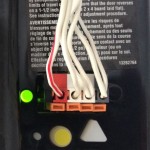How To Fix a Broken Garage Door Cable
A garage door system relies on a complex interplay of components to ensure smooth and safe operation. Among these, the cables play a crucial role in lifting and lowering the door. When a garage door cable breaks, it can render the door inoperable and potentially create a hazardous situation. Attempting to repair a broken garage door cable is inherently risky due to the high tension involved. It is strongly advised to consult a qualified garage door technician. However, understanding the process and potential hazards is beneficial for informed decision-making.
This article outlines the general steps involved in fixing a broken garage door cable, emphasizing safety precautions and highlighting scenarios where professional assistance is mandatory. The information provided is for educational purposes only and should not be considered a substitute for professional guidance. Working on garage door systems carries significant risks, including serious injury or death.
Identifying the Problem and Assessing the Risks
Before attempting any repair, a thorough inspection is essential. Begin by visually examining the garage door, paying close attention to the cables, springs, rollers, and tracks. Identify which cable is broken or damaged. Common signs include a frayed cable, a completely severed cable, or a cable that has slipped off its drum. Note the type of garage door system: torsion spring or extension spring. This distinction is critical because the spring system dictates the repair procedure and associated safety hazards.
Torsion spring systems are located above the garage door opening and utilize tightly wound springs to provide the lifting force. These springs store an immense amount of energy, even when the door is closed. Releasing this energy unintentionally can lead to severe injury or even death. Extension spring systems, on the other hand, are located along the sides of the garage door tracks. While they also store energy, they are generally considered slightly less dangerous than torsion springs, although still posing a significant risk.
Assess the overall condition of the garage door system. Look for signs of rust, corrosion, wear and tear, or any other damage. If the garage door is noticeably unbalanced or if the springs appear to be damaged or stretched, it is imperative to contact a professional. Attempting to fix a broken cable on a system with other underlying issues can exacerbate the problem and increase the risk of accidents.
Gather the necessary tools and safety equipment. These typically include: safety glasses, work gloves, a winding bar (for torsion springs only, and only to be used by trained professionals), locking pliers, a set of wrenches, and a new garage door cable compatible with the existing system. Never attempt to reuse a damaged or frayed cable. Using the wrong type of cable can also lead to premature failure and potential accidents.
Disconnect the garage door opener from the power outlet. This prevents accidental activation of the opener during the repair process. If the garage door has a manual release handle, use it to disengage the door from the opener mechanism. Secure the garage door in the closed position using locking pliers clamped to the track just above the bottom rollers. This will prevent the door from suddenly rising while working on the cables. If the door is already partially open, use a ladder or other appropriate support to hold it in place before securing it with locking pliers. Never rely solely on the garage door opener to keep the door in position.
Replacing a Broken Cable on an Extension Spring System (With Extreme Caution)
This section outlines the general process for replacing a broken cable on an extension spring system. However, it is crucial to reiterate the inherent risks involved and the strong recommendation to seek professional assistance. If choosing to proceed, exercise extreme caution and follow each step meticulously.
First, carefully inspect the extension springs. They should be properly secured with safety cables that run through the center of the springs. These cables prevent the spring from flying off in case of breakage. If the safety cables are absent or damaged, do not proceed. Contact a professional immediately.
To relieve tension on the springs, you may need to clamp the track or use C-clamps to secure the door further. The goal is to minimize the potential for sudden movement or spring recoil. Measure the length of the old cable to ensure the new cable is the correct size. Thread the new cable through the appropriate pulleys and brackets, following the same path as the old cable. Ensure the cable is properly seated in the grooves of the pulleys.
Attach the cable to the spring mechanism. This typically involves hooking the cable onto a designated bracket or loop. Ensure the connection is secure and that the cable is properly aligned. Repeat the process for the other side of the garage door, ensuring that both cables are equally taut. Unequal tension can cause the door to operate unevenly and put undue stress on the system.
Once both cables are installed, carefully remove the locking pliers from the track. Slowly raise and lower the garage door manually, observing the movement of the cables and springs. Check for any signs of binding, rubbing, or uneven tension. If the door does not operate smoothly or if there are any unusual noises, stop immediately and re-inspect the installation. It may be necessary to adjust the cable tension or the spring tension to achieve proper balance.
Re-engage the garage door opener and test the operation of the door. Observe the door closely as it opens and closes, paying attention to the alignment, smoothness of movement, and any unusual sounds. If everything appears to be functioning correctly, perform a final inspection of all components to ensure they are properly secured and in good working order.
Replacing a Broken Cable on a Torsion Spring System (Extremely Dangerous - Professional Assistance Required)
Replacing a broken cable on a torsion spring system is significantly more complex and dangerous than working with extension springs. Torsion springs store an immense amount of energy and require specialized tools and expertise to handle safely.
Attempting to perform this repair without proper training and experience can result in serious injury or death.
The fundamental principle involves carefully releasing the tension on the torsion springs using winding bars. This process requires specific knowledge of the spring system and the correct procedure to avoid uncontrolled release of energy. Once the tension is relieved, the broken cable can be replaced, and the spring tension can be carefully restored. This process requires precise measurements and adjustments to ensure the door is properly balanced and operates smoothly.
Due to the inherent risks, this section does not provide detailed instructions on replacing a broken cable on a torsion spring system. Instead, it serves as a strong reminder of the dangers involved and the absolute necessity of seeking professional assistance. Contact a qualified garage door technician immediately if you encounter this situation.
Professional garage door technicians have the training, experience, and specialized tools to safely and effectively repair or replace torsion spring systems. They can also identify any underlying issues that may have contributed to the cable failure and provide appropriate solutions. Choosing professional service ensures the safety of yourself and your property.
After completing any repair, whether performed independently (with extreme caution on extension springs) or by a professional, it is essential to regularly inspect the garage door system. Check the cables, springs, rollers, and tracks for signs of wear and tear. Lubricate moving parts as needed to ensure smooth operation. Address any minor issues promptly to prevent them from escalating into more significant problems. Regular maintenance can extend the lifespan of the garage door system and prevent costly repairs in the future.
In summary, fixing a broken garage door cable requires a thorough understanding of the risks involved and the correct procedures to follow. Extension spring systems are less dangerous but still pose risks. Torsion spring systems should only be handled by qualified professionals. Prioritize safety at all times and never hesitate to seek professional assistance when needed. Proper maintenance and regular inspections can help prevent cable failures and ensure the continued safe and reliable operation of the garage door system.

Comprehensive Guide To Repairing Broken Garage Door Cables

How To Fix And Install New Garage Door Cables Youtube

What To Do If My Garage Door Cable Breaks

Garage Door Cable Repair 101 How To Deal With Broken Cables

Replace My Broken Garage Door Lift Cable

How To Replace Both Cables On A Garage Door Torsion Spring System

How To Fix A Broken Garage Door Cable Repair Diy Maintenance Howto Youtube

How To Repair A Garage Door Cable Sdm Doors

Garage Door Cable Replacement Doors Lynchburg

My Garage Door Cable Snapped Why What To Do Jae S Anything








